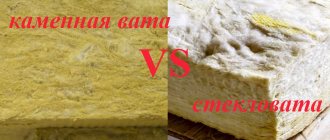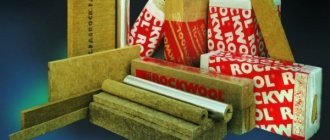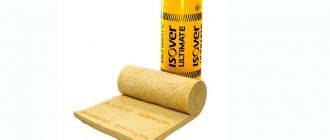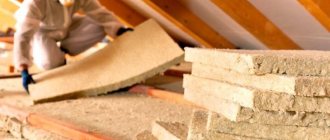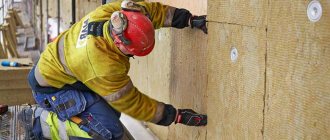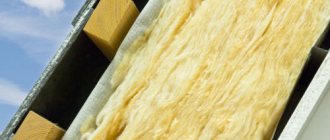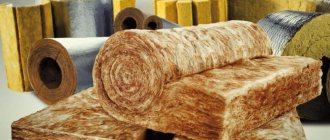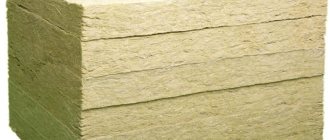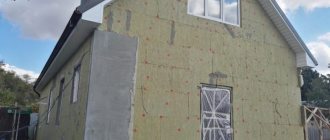In the range of household and industrial thermal insulation, the leading positions are occupied by affordable, easy to install and durable mineral insulation. In this article you will learn about stone wool and mineral wool - the main differences and similarities between these popular insulation materials.
What is stone wool?
In the category of the most popular thermal insulators there are several varieties of so-called basalt-fiber stone wool, made from molten volcanic rocks.
Thermal insulation, universal in many respects, is produced in the form of slabs of different densities and thicknesses, flexible roll coverings, split cylinders and other products. Stone wool is characterized by a large number of useful properties.
The main advantages of stone wool
Material assets include:
- unique in its class heat resistance and low thermal conductivity in the range of 0.036-0.038 W/m K;
- full compliance with current environmental standards and regulations, which determines the suitability of the material for thermal insulation of residential and industrial facilities for various purposes;
- stability of basic operational parameters throughout a service life of at least 50 years.
The insulation is not subject to shrinkage and deformation under the influence of a wide range of static and dynamic loads.
Stone wool has impeccable compatibility with organic and mineral substrates, as well as a wide variety of decorative and protective coatings, and is characterized by vapor permeability and effective noise absorption. The material is used without restrictions in a wide range of internal and external thermal insulation works of different levels of complexity.
Basalt heat-protective coating is capable of protecting building structures from extreme overheating and destruction for a long time. The current range includes insulation of different densities, allowing you to select a material for thermal insulation of new houses and secondary housing facilities.
Attention! In the production of budget stone thermal insulation, unscrupulous manufacturers often use substandard binders with a high content of slightly toxic formaldehyde resins. When purchasing material, it is recommended to give preference to certified products from a well-known brand.
Thermal conductivity
Thermal conductivity is the ability of a material to transfer thermal energy from a warm part of the material to a colder part. When it comes to insulating walls or floors, the lower the indicator, the longer the external cold will not be able to penetrate the room, and therefore heating costs will be reduced. In the summer heat, thermal conductivity has the opposite effect and helps keep the inside of the house cool.
Due to its fibrous structure, heat transfer through mineral wool depends on the thickness of the threads. Glass wool with fibers of 5-15 microns has a thermal conductivity index of 0.038-0.046 W/(m*K). And basalt wool, with fibers with a cross-section of 3-5 microns, begins its minimum value from 0.033 W/(m*K). Since insulation made from a basalt base has thinner threads, heat transfer through them takes longer, which makes it a leader in this characteristic.
Difference between stone wool and mineral wool
The effectiveness of wall, ceiling or floor insulation depends on whether stone wool or mineral wool is used as the main insulation.
- The mineral assortment is made from two types of raw materials - higher quality fiberglass or cheap slag. Both insulation materials are characterized by positive and negative aspects.
- Mineral-based insulation materials are made from quartz sand or broken glass. Fiberglass panels or flexible roll coverings are distinguished by lighter weight, high-quality heat retention and full sound insulation properties.
- The advantages also include strength and resistance to deformation loads.
A significant drawback of the material is the need to install a fiberglass covering with a full set of protective equipment, masks, gloves and exhaust ventilation. Glass dust that gets into the lungs can adversely affect the health of workers.
Mineral insulation based on blast furnace slag has more disadvantages than advantages. The affordable price does not compensate for the chemical reactivity of the material in relation to metal structures, moderate thermal conductivity and limited resource.
The scope of application of slag wool includes insulation of underground structures and structures, including foundations and industrial pipelines.
Price list
Insulation of ventilation façade with cladding
| Name | Without insulation | 50mm | 100mm |
| — porcelain stoneware, rub/m2 | 3045 | 3330 | 3440 |
| — fiber cement panels, rub/m2 | 3175 | 3460 | 3570 |
| — metal cassettes, rub/m2 | 3415 | 3700 | 3810 |
| — Clinker tiles, rub/m2 | 5245 | 5530 | 5640 |
| — Aluminum cassettes, rub/m2 | 6860 | 7145 | 7255 |
| — Planken, rub/m2 | 4815 | 5100 | 5210 |
| — Composite cassettes, rub/m2 | 3520 | 3805 | 3915 |
| — Metal siding, rub/m2 | 2715 | 3000 | 3110 |
| — Profiled sheet, rub/m2 | 2215 | 2500 | 2610 |
| — Terracotta panels, rub/m2 | 7815 | 8100 | 8210 |
| — HPL panels, rub/m2 | 6860 | 7145 | 7255 |
| — Natural stone, rub/m2 | 6090 | 6375 | 6485 |
| Name / thickness of thermal insulation | 60mm | 80mm | 100mm |
| Turnkey installation of thermal panels lined with artificial stone, rub/m2 | 3300 | 3450 | 3550 |
Criterias of choice
The differences between stone wool and mineral wool are more than significant, so the insulation in terms of cost, density, heat retention and other parameters is selected in accordance with the requirements of the design documentation.
Mineral wool and stone wool - the difference in the cost of the project, as well as the efficiency and durability of operation. In most cases, experts advise giving preference to materials made from basalt stone wool, which is universal in many characteristics, domestic or foreign assortment.
You can buy stone or mineral wool from us.
Results
Both materials can withstand high temperatures and belong to the flammability group NG (non-flammable). The cost is approximately the same. According to the manufacturers, these insulation materials do not harbor mice, but this is not true. Rodents take root almost everywhere.
Today we figured out what is better: mineral wool or stone wool. By mineral wool, we (like everyone who asks such questions) mean glass wool. Having compared the characteristics, we determined that glass wool is environmentally cleaner, does not generate dust during installation and does not chip. It is better for interior work. If we are talking about laying thermal insulation under screed or plaster in places with high humidity, then basalt thermal insulation is preferable. It does not absorb moisture so much and retains its thermal insulation properties even when wet.
Comparison of materials
Installation is carried out in the same way in both cases. However, it is necessary to take into account the difference between mineral wool and basalt wool.
It should be taken into account that basalt wool has a relatively dense consistency. This makes it more brittle and less elastic. Both materials can be used to insulate horizontal or vertical surfaces. Thermal insulation material may completely or partially lose its properties when exposed to moisture.
Basalt wool can withstand thirty percent wetness with virtually no loss. Since this material does not shrink, it can be used for laying in a screed or placed under plaster.
Mineral wool has less density and weight. It is soft and can absorb liquid well. When installing, it is important to provide this insulation with reliable moisture protection and vapor barrier.
Installation of basalt insulation Source pro-instrymenti.ru
Penoplex or mineral wool: which is better?
The first battle is penoplex or mineral wool: which is better. It is worth recalling that both materials claim to be unique for creating a layer of thermal insulation; we have already looked at what mineral wool is in construction. Let's see which materials are worthy of our attention, and which ones we can watch and forget.
The first thing we will consider is the pros and cons of penoplex. We will tell you a lot more about mineral wool. Now a little about penoplex. Of course, in terms of thermal insulation, penoplex is slightly inferior to cotton wool, but penoplex is a solid material that does not contribute to the development of fungi on its surface. Unlike porous and fibrous mineral wool, which is ready to begin to rot when exposed to moisture, it can be safely included in the estimate for a membrane roof according to this indicator.
Penoplex is not subject to crumbling during operation; mineral wool will happily crumble and settle directly into the structure. When dismantling and installing a soft roof, it is more convenient to cut penoplex to the required sizes; cutting mineral wool is akin to an atomic threat: you need a special suit, a respirator, gloves, and goggles.
Combustion of materials: mineral wool wins, it is practically resistant to combustion, but penoplex melts, releases toxins, in general, in this aspect there is no hope for it.
How to cut mineral wool?
How to cut mineral wool is a very important question, because the fibrous structure of the material that is used to maintain thermal insulation properties must maintain an integral structure, i.e. using simple scissors is not acceptable. To install and repair soft roofs, it is necessary to use a special machine to cut the mineral wool.
If using a machine is not possible due to its high cost, then you can use more affordable tools: a hacksaw for metal or wood. You can use a mounting knife, but it is not very large, so if the canvas is thick, cutting it with this knife will be inconvenient.
What other tools can be used to cut mineral wool? The knife blade is better if it is made of stainless steel. It is very important that the materials used have a sharp blade, otherwise it will not cut, but tear the cotton fibers.
When working with mineral wool, you must follow safety rules, because... Mineral wool dust is harmful to human health; when working with it, it is necessary to close the respiratory tract and mucous membranes of the nose and eyes. It is better to cut the material in a roll so that there is less dust in the air, but still the room in which work with mineral wool is carried out should be well ventilated.
What to give preference to?
There is no universal answer to this question, since the choice is largely determined by the specific situation. The owner must independently figure out what and how he will insulate. And only after that go to the store for a heat insulator.
Important indicators are:
- Features of installation or installation. For example, soft material cannot be secured in a vertical plane. It will still lose its shape and become deformed.
- Durability, safety and ease of use.
All mineral insulation materials not obtained from basalt rocks are highly deformed due to their relatively loose structure. For example, glass wool absorbs moisture and is compressed - it must be protected with a vapor barrier film on both sides.
But on the other hand, it helps a lot in insulating the attic and pipelines - the material bends easily. And the most modern brands are very similar in quality to cotton - the insulation does not prick at all, and is perfect for interior work.
Insulation of water pipes with cotton wool
Stone wool is resistant to deformation, does not absorb excess moisture well, and even when wet retains heat well. But at the same time it is quite brittle. It is extremely difficult to install it in a confined space that requires cutting individual slabs. Basalt dust quickly penetrates the lungs, causing irritation of the respiratory tract. Therefore, such insulation requires reliable insulation - particles of basalt slabs should not get into living spaces!
We can conclude that non-spiky glass wool is more suitable for indoor use, and stone wool for external use (installation on facades) and insulating the space between walls.
We understand the flammability and toxicity of polystyrene foam
As you can see, people's opinions are divided. And now the “heavy artillery”. Everyone has heard that polystyrene foam is a flammable material. Perhaps this is the main reason why many are against the use of expanded polystyrene for insulating frame walls and “for” non-flammable stone wool.
Igor D. FORUMHOUSE participant
When burning, foam releases toxic substances. During a fire, a person may simply not crawl to the exit. He will suffocate. For example, if the fire occurred at night. I once saw myself how a building under construction, which was insulated with foam plastic, was burning. There was a terrible stench and a lot of smoke. By the way, the SES then froze the construction of the building for a year until everything cleared up.
DikanaForumHouse Member
I once set fire to PSB 25 foam plastic. A piece melted and released something caustic. As I understand it, it itself doesn’t really support combustion. But it melts at low temperatures. If it flares even just a little, you will simply suffocate in such a room.
Let's be clear. Expanded polystyrene comes in different forms . For example, modified, i.e. - containing fire retardants and regular ones.
Fire retardants slow down the processes of ignition and combustion.
Polystyrene foam with fire retardants is designated by the letter C. These are PSB-S-15, PSB-S-25, PSB-S-35 and PSB-S-50. The number at the end indicates the density grade. Flammability group of ordinary polystyrene foam, without fire retardants, G4 , i.e. - highly flammable material.
, a whole bunch of harmful chemicals are released hydrogen cyanide - hydrocyanic acid - a volatile, easily mobile liquid, which is a strong poison.
Inhaling hydrocyanic acid or getting it inside the body leads to loss of consciousness and death.
Expanded polystyrene with the letter “C” is self-extinguishing, i.e. goes out when there is no source of fire . Its flammability group is G3 - normally flammable materials. To be fair, let’s say that when wood burns, carbon monoxide is released , the so-called. Carbon monoxide is colorless and odorless. Inhalation of carbon monoxide during a fire leads to poisoning, loss of consciousness, and, in high concentrations, death.
By the way, when burning ordinary paper and cardboard, hydrogen cyanide is also released , although in much smaller quantities (about 100 times) than when burning polystyrene foam. But there is one “But”.
From the point of view of fire hazard, insulation should not be considered separately by itself, but mounted in the “pie” of the wall.
If the foam is covered with non-flammable material , for example, hypo-fiber sheet (GVL) or fire-resistant plasterboard (GKLO), then the fire resistance of the entire structure as a whole is calculated.
The fire resistance indicator characterizes the ability of building structures to limit the spread of fire, as well as maintain the necessary performance characteristics at high temperatures in fire conditions.
In practice, this means that if the fire reaches the foam in the wall, there will be no one to save. Why?
Most often, people die in fires not due to direct exposure to the flames, but because they inhaled toxic substances contained in the smoke, lost consciousness, or were poisoned by toxic gases.
In the event of a fire, the first thing that burns in a cottage is the decoration, furniture, clothing, interior items and household appliances . Now look back and see what they are made of? Most likely from highly flammable and non-flammable materials - plastic of all types, wood, fabric + paint. Those. everything that, when burned, is not inferior to polystyrene foam in releasing all sorts of chemical nasty things.
The design must be designed in such a way that the residents of the house have time to leave the building.
The best basalt wool
The best mineral wool for insulation - every owner is looking for it. After all, the result of all work depends on the quality of the material. There are quite a few manufacturers on the market today, the range is very wide.
Based on customer reviews, the brand rating may look like this:
- RockWool is a Danish manufacturer. The product is famous for its excellent quality and environmental friendliness.
- Paroc – it has an excellent reputation and a fairly high price.
- TechnoNIKOL is one of the most popular iconic domestic manufacturers. The quality of the products is at a fairly good level. It is worth noting the affordable prices. It was this company that began to produce a type of mineral wool that does not generate dust when cutting. These products are produced under the Rocklight brand.
- Izovol is a domestic brand. The materials are more affordable in price compared to foreign analogues. They are of good quality. However, consumers often note that the insulation crumbles while working with it.
- Isover - French-made products. It is famous for its harmonious ratio of quality and cost.
Usage
The main use is to provide thermal insulation. In this sense, the materials have approximately the same characteristics. There are differences, but they are minor.
These materials can also be used for sound insulation. This plays an important role, for example, where there is heavy traffic or in apartment buildings with good audibility.
Insulation of facades with slabs Source vitebsk.pulscen.by
Some designs use the load-bearing properties of the materials in question. An example is inversion roofs. In this case, the density and elasticity of the material play an important role.
Both basalt and mineral wool have a high degree of fire protection. If they get caught in a fire, the fibers will not burn, but will bake. Some other insulation materials are significantly inferior in such characteristics, being flammable materials. For example, this applies to polystyrene foam.
Carrying out work
Creating a thermal insulation layer requires following general rules. Regardless of the characteristics of a particular material, it is necessary to create conditions for its most effective use. The following must be taken into account:
- Although different types have different resistance to moisture, it is necessary to provide adequate protection for them. It is important to understand that, for example, if rain wets the thermal insulation layer of the roof, it will cease to perform its functions. A similar situation arose when groundwater entered the layer protecting the basement.
- If moisture has already gotten inside, you need to create the opportunity for ventilation and vapor barrier. Under such conditions, the liquid will gradually evaporate, ensuring the normal functionality of the protective layer.
- Although the material is often considered to be well protected from rodents and insects, it is nevertheless better to take additional measures to ensure this.
- In the production of basalt or mineral wool, special chemical compounds are used. During production, safety measures are observed to ensure the harmlessness of the material. However, you need to understand that there are different technological processes and in some cases you cannot be sure of 100% environmental friendliness. Therefore, when installing a layer, you need to ensure that it is well closed.
- During operation, dust may be generated to varying degrees, which can be harmful to health. This is due to the fragility of the fibers. Therefore, it is important to ensure that the wool layer is sealed tightly.
- In conditions of high humidity and for outdoor work, it is beneficial to use basalt wool. It will be more effective due to good mechanical strength and relatively high moisture resistance. To secure it, you can use a lathing or use special dowels with a wide head instead.
- If you need a material that will have to be used in conditions of strong heating, then it is more profitable to use basalt wool. This is due to increased resistance to temperature effects and the fact that no harmful substances are released when heated.
- If the materials in question are used to insulate areas of complex configuration and high-quality insulation cannot be counted on, it is necessary to ensure that the safest material in this regard is used.
Overview of the range of mineral wools
The insulation received this name because the product is based on natural minerals, sometimes even some types of stones. What is their fundamental difference, and what is better to use for insulating a house or roof, our article will answer.
- Glass wool is the most famous and popular product of modern construction insulation technologies. The cost per linear meter is low, and the quality indicators are very high - it retains its original properties for a long time if all installation conditions are fully met. Produced from quartz mineral stone by extremely fine splitting under special thermal conditions. In fact, this is a very economical and at the same time high-quality insulation, and the latest technologies have rid the cotton wool of harmful glass impurities, but not all manufacturers strictly follow the process technology, so there may be residual effects of poor quality mineral wool in terms of environmental indicators. But for safety reasons, it is better to wear gloves and a protective suit. It is convenient to work with it - the products are supplied in rolls of the required length, low weight indicators will make it easy to insulate the house even when alone.
- Slag, as can be understood from the name, is produced from metal production waste, when by adding ore and coal, steel and slag waste are obtained, that is, a kind of suitable mineral for secondary raw materials. In addition to lump slag, dusty residues and other small fractions can be added to it, which are used as filler, which affects the quality characteristics of products for thermal insulation of premises. The main threads are obtained by blowing the liquid fraction with a pore powerful jet or compressed air; during the process it is additionally saturated with silica filler. The fibers then go through the stage of pressing and forming the finished product into large rolls. Negative aspects are visible in the low quality of the canvas; moreover, over time, it begins to emit acidic fumes, which does not allow the use of insulation for residential premises. In the photo - slag:
- Stone cotton blocks for insulation. It should be noted right away that this is a large group of insulation materials that can be divided into organic and inorganic origins: The organic type includes wood fiber wool, peat, pyroclastic, that is, they are made from natural elements with virtually no preparatory treatment. Since the base of wool is natural, the environmental performance of such insulation materials is quite high, and they are also lightweight and easy to use;
- Mineral wool made from asbestos fibers is considered inorganic. (by the way, very harmful, they can be deposited on the lungs and will never be eliminated from the body), basalt and other stone minerals, but they all have the name of inorganic origin. All such products, except for the asbestos type, are absolutely safe for human health, and they can be used to insulate any residential premises.
Now let's talk about the main differences between basalt wool and other types of mineral wool.
General Tips
A few rules and notes for quality work.
Without the correct selection and use of glue, the insulation may sag and cease to act effectively. Stone wool is a rather unusual material, and not every adhesive can provide high-quality adhesion to the wall.
Polymer-cement compositions will provide the highest adhesion. They are sold as a dry mixture similar to cement. There are several well-known brands: “EK THERMEX”, “ERESIT CT190”, “ERESIT CT180”.
Following the instructions on the package, dilute the mixture with water and mix well (repeat after 5 minutes). The solution will retain its adhesive properties for 2 hours.
Apply the solution evenly onto a flat surface of the wall so that you get 7-8 glue circles. We also apply glue to the back side of the cotton wool (closer to the edges); the surface should be covered with the composition more than half. It is also better to coat the joints. The glue hardens for some time, so it is possible to lay the slab correctly. Attaching stone wool to a wall is simple.
Sometimes, for greater reliability, additional fastening may be required. Anchor bolts or slats secured to the sheathing can help here.
Video description
Mineral wool or stone wool?
Mineral wool is also produced from metallurgical slag. In particular, it differs from other varieties in its high tensile strength.
This material has gained popularity when used for various purposes. It is suitable not only for thermal protection of the walls or roof of a house, but also for the installation of high-temperature systems and pipelines. A layer of such material can be used to insulate cabins for insulation and noise protection.
Installation of the insulating layer Source remontami.ru
Density and mass of materials
Density affects the mass of a material. The denser the slab, the more weight it will have on the insulated structures. Glass wool has a density from 11 to 200 kg/m3. Stone wool is produced with a density of 15-220 kg/m3.
With the same roll sizes, stone wool is denser and is clearly in the lead, but this victory has a second side - weight. In the case of a ceiling, second floor floor or walls, basalt slabs will exert greater pressure on the structures underneath, which must be taken into account at the design stage.
What is better to insulate with polystyrene foam?
This material has proven itself very well in places where air humidity is quite high but insulation is required.
- Foam plastic will not do anything when in contact with wet ground, so it can perfectly insulate foundations, as well as various engineering structures located underground. Tens of years will pass, and the insulation will remain the same as at the very beginning. It is often used in the construction of multi-layer foundations as a middle layer. It turns out to be a very reliable and high-quality foundation.
- When building houses without basements, on a monolithic foundation, it is also convenient to use polystyrene foam. Plates of this material are laid on a leveled area, and then a layer of concrete is poured on top of them. The slabs themselves can be either one row or several. After the concrete has hardened, the walls of the house begin to be erected.
- To prevent the foundation of the house from freezing, it is very effective to insulate not only its vertical, but also its horizontal part with polystyrene foam. Expanded polystyrene slabs are laid along the foundation. Then they are backfilled, if necessary, additionally laying a waterproofing layer. This method of insulation reliably protects the foundation from frost.
- The walls of houses (both inside and outside) can also be effectively insulated with polystyrene foam. It is best if these walls are block or brick. A high thermal insulation effect is achieved when using polystyrene foam to insulate interior spaces, and the formation of a dew point is not observed.
- For non-ventilated roofs (warm, flat roofs), the PSBS grade of expanded polystyrene is used. A waterproofing layer must be placed on top. For cold roofs that are ventilated, thermal insulation is carried out differently. The inside of the roof is insulated with polystyrene foam, leaving space for ventilation. This prevents water vapor from condensing.
- It is also good to insulate floors and ceilings between floors with foam boards. A layer of insulating material is placed under them, and concrete is poured on top.
- A variety of packaging is also made from polystyrene foam, and it is also used for thermal insulation of refrigerators, freezers and special isothermal vans.
New products on the market: convenient format and high environmental friendliness
Due to the constant competition for their place in the sun, manufacturers are constantly improving the quality of their products or coming up with new products that cannot fail to interest potential buyers.
Let us separately note the popular new product from Rocklight – Rocklight Mini. These are stone wool slabs measuring only 800x600 mm, compared to the more common 1200x600 mm. This format allows you to more accurately calculate the required amount of insulation, avoid mistakes and more conveniently deliver the slabs in your own car.
The eco-friendly insulation GreenGuard, developed using GEOlife technology from TechnoNIKOL, is quickly becoming famous. The peculiarity of the technology is that exclusively natural components are used here: only rocks of the basalt group and biopolymer binders of organic rather than synthetic origin. This type of rock is characterized by high refractoriness, and therefore cotton wool is quite fire-resistant. Therefore, the material is assigned the maximum fire safety class.
Such insulation not only does not burn and does not change shape, but also serves as a certain barrier to fire. And at the same time there will be no poisonous gases or toxic substances, because there are no resins here at all. Modified starch and an organic thickener are used as a binder. The same substances are used today in the food, perfume and diaper industries.
